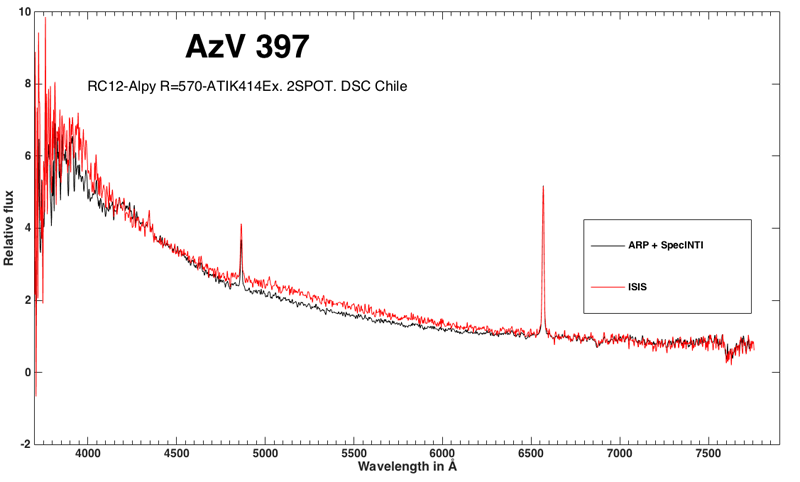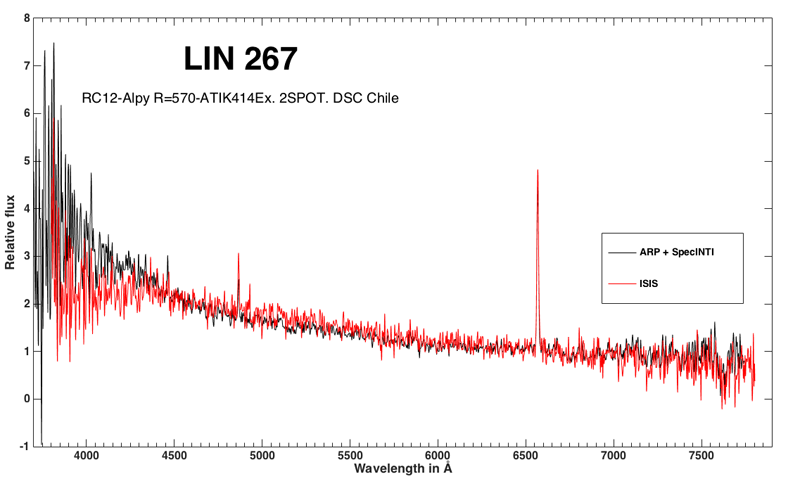Page 1 of 1
Process comparison ISIS vs ARP SpecINTI
Posted: Sat Sep 10, 2022 7:45 am
by Olivier GARDE
Here're the comparison between two different process :
- A classical manual process made by ISIS (Red curves)
- An automatic process with ARP and SpecINTI (no human intervention)
The 2 targets are Be star in the SMC taken automatic mode with prism software and a script (no human intervention for the acquisition) :
- AzV 397 : mag. V=14,03 6x1200s with ATIK 414ex in bin 1x1
 - Lin 267 :
- Lin 267 : Mag. V=14,91 6x1200s with ATIK 414ex in bin 1x1

Re: Process comparison ISIS vs ARP SpecINTI
Posted: Tue Sep 27, 2022 1:26 am
by Peter Velez
Olivier
This is an impressive result. I am interested in understanding how you are managing the production of the response curve using ARP.
I can understand how you would determine the parameters for the efficient production of the response curve using SpecINTI. However, unless all your targets are in the same region of the sky, I would have thought you would need to image a reference star, produce the response curve from that reference star and then apply it to the target. This would mean that your batch processing system operates iteratively ie process a reference star, produce a response curve, process the target and then start the process again for the next target.
If so, you have a very smart processing pipeline.
The alternative is to produce an instrument response curve and use SpecINTI to generate and apply a suitable ATM fits file. Again, an impressive effort.
Are you able to satisfy my curiosity on this?
Francois - you may want to move this post to the Software sub forum - I don’t know how to do that
Pete
Re: Process comparison ISIS vs ARP SpecINTI
Posted: Tue Sep 27, 2022 10:51 am
by Olivier GARDE
Hello Pete,
we manually made "generic" instrumental responses at various heights in the sky (every 10 degrees, from 30 degrees to zenith), in fact a library of IR
Afterwards, when making automatic observations, a target list is created in a .csv format with the name of the target, its coordinates, the magnitude and the observation priority. This way we have consequent lists of several hundred objects.
The Prism script takes over by selecting from this list the targets best placed in the sky or according to their degree of priority of observations and then launches the acquisitions in automatic (pointing the target in the slit, choosing a guide star other than the target, and launching the acquisitions until dawn)
Once the observations are complete, the ARP pipeline takes over and processes all the spectra by applying a generic IR (from ou IR library) based on the average height of the target.
For targets that require more than 600s of unitary exposure, we no longer even use a calibration lamp because we calibrate the spectrum with the [OI] 5577.35Å line
At the end of the treatment, ARP offers us a dashboard that presents us with the results of the night that we can validate or not.
If one of the targets is not correct in terms of continuum, then it can be redone manually (this mainly concerns targets less than 30 degrees high and therefore with a large air mass)
Re: Process comparison ISIS vs ARP SpecINTI
Posted: Tue Sep 27, 2022 12:37 pm
by Peter Velez
Thanks for the explanation Olivier.
Your scripting with Prism is more automatic than my approach with Voyager - which I will post about separately. It makes good sense, especially with a an Alpy. My UVEX with its narrower spectral range is a bit more tricky to manage I suspect.
I've started to play with SpecINTI and the example using the 2Spot data set has been invaluable, especially with the [OI] line calibration method. I can do the same at my location for long exposures. The recent video on automation for spectroscopy was also enlightening.
You have answered my query about the IR curve. The ARP pipeline is clearly quite sophisticated with the ability to select from a number of IR curves you have on file. I can't quite follow how you manage this in batch-mode, but that may be because I am not a software developer. I plan to keep tinkering as the possibility of automating basic processing is fascinating.
Pete
Re: Process comparison ISIS vs ARP SpecINTI
Posted: Tue Sep 27, 2022 8:24 pm
by Robin Leadbeater
Hi Olivier,
You have my attention

Why is the SNR so much better using Spec INTI ?
The use of a standard atmospheric correction is probably ok for 2SPOT's exceptionally good location but personally I would still take at least one standard star per night (like the professionals do) to give confidence that nothing has changed and if anything unusual is seen you can still correct your data.
Cheers
Robin
Re: Process comparison ISIS vs ARP SpecINTI
Posted: Wed Sep 28, 2022 5:02 pm
by Olivier GARDE
Hi Robin,
Yes you are right, it is because we are in Chile under an exceptional sky that we can free ourselves from an IR for each target. The nights are very stable and very repeatable from one night to the next except for a few rare nights where we have clouds or a bit of fog.
In automatic mode, we never take spectra with a target less than 30 degrees in altitude.
In our various tests, we made several targets with ref stars for each target and a general IR for the targets having the same height and the result is identical in the 2 processing methods. And of course we have verification methods to check if the profile obtained at the continuum level is good or not.
The nights in Chile are in their great majority all excelent as testifies this image of the camera all sky of the site of the observatory where we are (Deep Sky Chile) very close to the Gemini South telescope (to less than 40 kms)

and at home in France, I can't do this generic IR method because my sky is very variable even during the same night and the process does not give satisfactory results with continuums that melt the troughs and bumps not at all representative of the star studied.
For the SNR which is better with specinti it comes from the method in specinti where one has the choice to apply the master flat, either on each individual image (the traditional method) or on the result of the addition of the N images. one divides then an image having much more ADU than on a unitary image. It's a choice during the .yaml configuration file.




